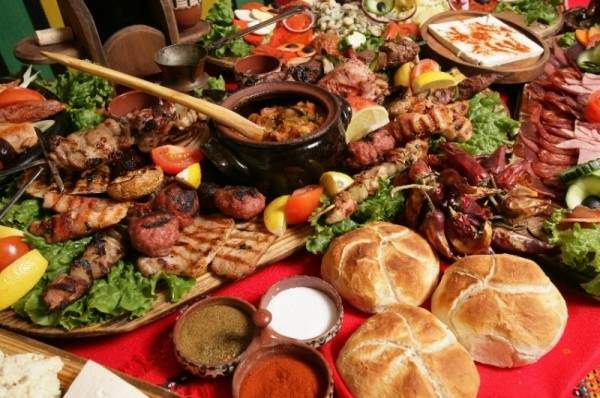 I dziś więc, jak przed wiekami, wyrabia się tu w zimie domowe wędliny z myślą o licznych w tym okresie świętach. Spędzając w Kopriwszticy Boże Narodzenie miałyśmy okazję próbować wspaniałą łukankę wyprodukowaną przez naszych gospodarzy. Ta sucha kiełbasa, stanowiąca idealną zakąskę do śliwowej rakii, przewyższała nawet smakiem doskonały „sudżuk” (odmiana łukanki o kształcie podkowy), który kupowałyśmy z wielkim trudem w sofijskich magazynach. Mistrzem sztuki wędliniarskiej okazał się dziadek pani domu, któremu nasze zachwyty sprawiały wyraźną przyjemność. Gdy więc dyskusja przy stole dotknęła spraw kulinarnych, dziadek Kosta bez wahania odkrył przed nami tajemnice gwarantujące powodzenie produkowanym przez niego wędlinom.
I dziś więc, jak przed wiekami, wyrabia się tu w zimie domowe wędliny z myślą o licznych w tym okresie świętach. Spędzając w Kopriwszticy Boże Narodzenie miałyśmy okazję próbować wspaniałą łukankę wyprodukowaną przez naszych gospodarzy. Ta sucha kiełbasa, stanowiąca idealną zakąskę do śliwowej rakii, przewyższała nawet smakiem doskonały „sudżuk” (odmiana łukanki o kształcie podkowy), który kupowałyśmy z wielkim trudem w sofijskich magazynach. Mistrzem sztuki wędliniarskiej okazał się dziadek pani domu, któremu nasze zachwyty sprawiały wyraźną przyjemność. Gdy więc dyskusja przy stole dotknęła spraw kulinarnych, dziadek Kosta bez wahania odkrył przed nami tajemnice gwarantujące powodzenie produkowanym przez niego wędlinom.
Przygotowując łukankę dla potrzeb domowych, bierze dziadek Kosta mniej więcej 8 kg kruchego mięsa wieprzowego, 2 kg słoniny i 4 kg mięsa cielęcego. Mięso przepuszcza przez maszynkę z gęstym sitkiem, a słoninę kraje w drobną kostkę. Całość miesza starannie z 200 g soli, 40 g czarnego pieprzu, 50 g kminku, 40 g cukru i niewielką ilością roztartego czosnku. Następnie odstawia masę w chłodne miejsce, a po upływie 24 godz. napełnia nią cienkie wieprzowe jelita i zawiązuje je z obu stron. Kiełbasy rozwiesza w przewiewnym miejscu, zwykle na strychu, aby wyschły.
Bardzo nas to szokowało, że wędliny domowe suszy się tu, a nie wędzi. Gdy jednak usiłowałyśmy włączyć do podawanej receptury nasze rady opowiadając o dymie jałowcowym, dziadek lekceważąco machał ręką. To nie to. I zaraz okazało się, że suszenie łukanki — to wcale nie taka prosta sprawa. Zgodnie z zasadami kuchni bułgarskiej, w której przyrządzenie każdej potrawy wymaga licznych czynności, powieszenie kiełbas na drążku nie jest oczywiście akcentem końcowym. Co jakiś czas, mniej więcej w odstępach tygodniowych, łukanki należy sprasowywać wałkiem lub po prostu butelką, aby otrzymały płaski kształt, co zapewnia im większą trwałość. Suszenie trwa ok. 50 dni, po czym zawija się łukanki w papier i przesypuje węglem drzewnym.
Dziadek Kosta, który wyraźnie nie obawiał się konkurencji i pobłażliwie traktował nasze zainteresowanie wyrobem wędlin, uzupełnił jeszcze swoje opowiadanie przepisem na „nadeniczki”. Sporządza się je przeważnie z mięsa wieprzowego, które miele się razem ze słoniną. Na 1 kg mięsa dodaje się 20 g soli, 4 g pieprzu, 4 g kminku i trochę czubricy. Dalszy ciąg postępowania jest analogiczny jak przy łukance z tym, że kiełbaski te suszy się nieco krócej. Nadenice podaje się tu również często świeże, po upieczeniu w piekarniku lub na ruszcie. Ponieważ kiełbaski te wyrabia się w cienkich i długich cielęcych jelitach, na talerzu przyjmują kształt śliniaczka. W takiej właśnie formie jadłyśmy je w snack-barze „Odessos” w Warnie, gdzie — serwowane z „Ijutenicą” (przecier pomidorowo-paprykowy z dodatkiem posiekanej drobno cebuli) — stanowiły nasze ulubione danie. „Ljutenica” pojawia się również w Polsce, niestety od pewnego czasu słoiki z wesołą etykietką znikły bezpowrotnie ze sklepowych półek.
Do bardzo poszukiwanych przez obcokrajowców wędlin bułgarskich należy też słynny „karłowski babek” — specjalność wytwórni w Karłowie, która jako jedyna w kraju produkuje tę kiełbasę. „Babek” sporządza się w jelitach owczych, z mięsa wieprzowego od szynki z dodatkiem boczku. Przygotowuje się go podobnie jak łukankę stosując jednak do mielonej masy mięsnej inne nieco przyprawy. Oprócz soli i pieprzu dodaje się do kiełbasy również saletrę, słodką czerwoną paprykę, cukier i kardamon.








